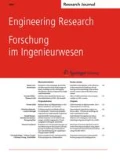Zusammenfassung
Flammentemperaturen (T), die spezifische Ausstrahlung (SEP) sowie Bestrahlungsstärken (E) in großskaligen JP-4-Poolfeuern (d=2, 8, 16, 25 m) und Di-tert-butylperoxid (DTBP)-Poolfeuern (d=1.12 m, 3.4 m) werden durch CFD Simulation vorhergesagt und experimentell bestimmt. Als Messmethoden werden ein IR-Thermografie Kamerasystem mit Videomischeinheit zur Ermittlung von T, SEP sowie ein Ellipsoidalradiometer zur Bestimmung von E herangezogen. Die häufigsten, zeitlich gemittelten Emissionstemperaturen für JP-4-Poolfeuer (d=16 m) liegen im Bereich \( 793\,\mathrm{K} < \overline{T} < 1033\,\mathrm{K}\) und für DTBP-Poolfeuer (d=1.12 m) im Bereich \( 1040\,\mathrm{K} < \overline{T} < 1480\,\mathrm{K}\). Für DTBP-Poolfeuer (d=1.12 m) beträgt die gemessene, mittlere \( \overline{\text{SEP}} \approx 130\,\mathrm{kW/m^{2}}\) und ist bis um den Faktor ≈6 größer im Vergleich zu KW-Poolfeuern (d≈1 m). Im Falle des DTBP-Poolfeuers (d=3.4 m) mit \( \overline{\text{SEP}} \approx 250\,\mathrm{kW/m^{2}}\) beträgt der Faktor ≈5 im Vergleich zur \( \overline{\text{SEP}} \approx 50\,\mathrm{kW/m^{2}}\) eines LNG-Poolfeuers (d=4 m). Die mit zunehmender, relativer Entfernung ∆y/d vom Poolrand abnehmenden, gemessenen mittleren Bestrahlungsstärken \( \overline{E}\) (∆y/d) stimmen mit den durch CFD Simulation bestimmten \( \overline{E}_{\text{CFD}}\) (∆y/d) i. A. gut überein. Ebenso liegt eine gute Übereinstimmung zwischen den gemessenen, mittleren \( \overline{T}\) und \( \overline{\text{SEP}}\) bei KW- und DTBP-Poolfeuern mit den durch CFD vorhergesagten \( \overline{T}_{\text{CFD}}\), \( \overline{\text{SEP}}_{\text{CFD}}\) vor. Die Möglichkeiten und derzeitigen Grenzen der CFD Simulation bei großen Bränden werden diskutiert.
Abstract
Flame temperatures (T), surface emissive powers (SEP) and irradiances (E) of large-scale JP-4 pool fires (d=2, 8, 16, 25 m) and di-tert-butyl peroxide (DTBP) pool fires (d=1.12 m, 3.4 m) are investigated experimentally and by CFD simulation. As experimental methods an infrared thermographic camera system with video-mixing unit is used for the determination of T, SEP and an ellipsoidal radiometer for the determination of E. The maximum frequency of time-averaged emission temperatures for JP-4 pool fire (d=16 m) are in a range of \( 793\,\mathrm{K} < \overline{T} < 1033\) and for DTBP pool fire (d=1.12 m) are a range of \( 1040\,\mathrm{K} < \overline{T} < 1480\,\mathrm{K}\). For DTBP pool fire (d=1.12 m), the measurements result in \( \overline{\text{SEP}}\approx 130\,\mathrm{kW/m^{2}}\) which is up to a factor of ≈6 larger in comparison to hydrocarbon pool fires (d≈1 m). In a case of DTBP pool fire (d=3.4 m) with \( \overline{\text{SEP}} \approx 250\,\mathrm{kW/m^{2}}\) this factor is ≈5 compared to \( \overline{\text{SEP}} \approx 50\,\mathrm{kW/m^{2}}\) of LNG pool fire (d=4 m). By increasing the relative distance ∆y/d from the pool rim, measured time averaged irradiances \( \overline{E}\) (∆y/d) decrease and agree well with CFD predicted \( \overline{E}_{\text{CFD}}\) (∆y/d). Also, there is a good agreement between the measured time averaged \( \overline{T}\) and \( \overline{\text{SEP}}\) of hydrocarbons and DTBP pool fires, with the predicted \( \overline{T}_{\text{CFD}}\) and \( \overline{\text{SEP}}_{\text{CFD}}\) values. The possibilities and nowadays limitations of CFD simulation of large pool fires are discussed. This study has shown that the risk potential of accidental pool fires referring to thermal radiation can be predicted much better than in the past.
Literatur
Hailwood M, Gawlowski M, Schalau B, Schönbucher A (2009) Chem Eng Tech 32:207
Göck D (1988) Experimentell fundierte Ballenstrahlungsmodelle zur Bestimmung von Sicherheitsabständen bei großen Poolflammen flüssiger Kohlenwasserstoffe, Dissertation, Universität Stuttgart
Fiala R, Göck D, Zhang X, Schönbucher A (1992) TÜ 33:137
Wehrstedt KD, Wandrey PA (1993) PTB-Bericht, Braunschweig
Mudan KS (1984) Prog Energy Comb Sci 10:59
Lees FP (2005) Lee’s Loss Prevention in the Process Industries, Mannan S (ed) 3th ed. Elsevier Butterworth-Heinemann, Burlington, MA
Schönbucher A (2008) Quellterme bei offenen Bränden von Flüssigkeiten und Gasen, interner Bericht
Tieszen SR (2001) Ann Rev Fluid Mechan 33:67
Koseki H (1997) Proc. of the 2nd Int. Symp. on Scale Modeling, Lexington
McGrattan KB, Baum HR, Rehm RG (1998) Fire Saf J 30:161
Spinti JP, Thornock JN, Eddings EG, Smith PJ, Sarofim AF (2008) In: Faghri M, Sunden B (eds) Transport Phenomena in Fires, WIT Press, Boston
Sinai YL (2000) Fire Saf J 35:51
Nicolette VF, Gritzo LA (1994) Proc. of the 4th Int. Symp. on Fire Safety Science, Ottawa
Chun H (2007) Experimentelle Untersuchungen und CFD-Simulationen von DTBP-Poolfeuern, Dissertation, BAM, Berlin
Muñoz M, Arnaldos J, Casal J, Planas E (2004) Comb Flame 139:263
Muñoz M, Planas E, Ferrero F, Casal J (2007) J Hazard Mater 144:725
Fay JA (2006) J Hazard Mater 136:219
Raj PK (2007) J Hazard Mater 140:280
Raj PK (2005) Process Saf Progr 24:192
Engelhard WFJM (1997) In: v. d. Bosch CJH, Weterings RAPM (eds) Yellow Book, 3th ed., The Committee for the Prevention of Disasters, TNO, Den Haag
Gawlowski M, Hailwood M, Vela I, Schönbucher A (2009) Chem Eng Tech 32:182
Kuhr C (2008) CFD-Simulation der dynamischen Eigenschaften großer Kerosin- und Heptan-Poolflammen, Dissertation, Universität Duisburg-Essen
Jensen KA, Ripoll J-F, Wray AA, Joseph D, El Hafi M (2007) Comb Flame 148:263
ANSYS CFX 11 User Guide, AEA Technology (2008)
Lautenberger C, de Ris J, Dembsey N (2005) Fire Safe J 40:141
American Petroleum Institute, Report API 521, Washington (1969)
Seeger PG (1971) Z VFDB 20:74
Cetegen BM, Kasper KD (1996) Phys Fluids 8:2974
Ferziger JH, Peric M (1997) Computational Methods for Fluid Dynamics, 2nd ed. Springer, Berlin
Author information
Authors and Affiliations
Corresponding author
Rights and permissions
About this article
Cite this article
Vela, I., Chun, H., Mishra, K.B. et al. Vorhersage der thermischen Strahlung großer Kohlenwasserstoff- und Peroxid-Poolfeuer mit CFD Simulation . Forsch Ingenieurwes 73, 87–97 (2009). https://doi.org/10.1007/s10010-009-0094-3
Published:
Issue Date:
DOI: https://doi.org/10.1007/s10010-009-0094-3

